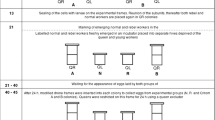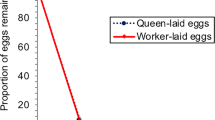Summary
The study investigates whether worker policing via the selective removal of worker-laid male eggs occurs in normal honey bee colonies with a queen. Queenright honey bee colonies were set up with the queen below a queen excluder. Frames of worker brood and drone comb were placed above the queen excluder. Daily inspections of the drone frames revealed the presence of a few eggs, presumably laid by workers, at a rate of 1 egg per 16000 drone cells. 85% of these eggs were removed within 1 day and only 2% hatched. Dissections of workers revealed that about 1 worker in 10000 had a fully developed egg in her body. These data show that worker egg-laying and worker policing are both normal, though rare, in queenright honey bee colonies, and provide further confirmation of the worker policing hypothesis.
Similar content being viewed by others
References
Bourke AFG (198) Worker reproduction in the higher eusocial Hymenoptera. Q Rev Biol 63:265-289
Farrar CL (1937) The influence of colony populations on honey production. J Agric Res 54:945–954
Free JB, Williams H (1975) Factors determining the rearing and rejection of drones by the honeybee colony. Anim Behav 23:650–675
Harbo JR (1986) Effect of population size on brood production, worker survival and honey gain in colonies of honeybees. J Apic Res 25:22–29
Hess G (1942) Über den Einfluss der Weisellosigkeit und des Fruchtbarkeitsvitamins E auf die Ovarien der Bienenarbeiterin. Schweiz Bienen Zeitung 2:33–110
Jay SC (1968) Factors influencing ovary development of worker honeybees under natural conditions. Can J Zool 46:345–347
Jay SC (1970) The effect of various combinations of immature queen and worker bees on the ovary development of worker honeybees in colonies with and without queens. Can J Zool 48:169–173
Jay SC (1972) Ovary development of worker honeybees when separated from worker brood by various methods. Can J Zool 50:661–664
Kropáčová S, Haslbachová H (1969) The development of ovaries in worker honeybees in a queenright colony. J Apic Res 8: 57–64
Kropáčová S, Haslbachová H (1970) The development of ovaries in worker honeybees in queenright colonies examined before and after swarming. J Apic Res 9:65–70
Kropacova S, Haslbachova H (1971) The influence of queenlessness and of unsealed brood on the development of ovaries in worker honeybees. J Apic Res 10: 57–61
Jeffree EP (1955) Observations on the decline and growth of honey bee colonies. J Econ Entomol 48:723–726
Maurizio A (1954) Pollenernährung und Lebensvorgänge bei der Honigviene (A.M.L.). Landwirtsch Jahrb Schweiz 68:115–182
Nelson DL, Jay SC (1972) Estimating numbers of adult honeybees on Langstroth frames. Manitoba Entomol 6:5–8
Pain J (1968) L'ovaire des ouvrières. In: Chauvin R (ed) Traité de biologie de l'abeille, vol 1. Masson, Paris, pp 186–199
Page RE, Erickson EH (1988) Reproduction by worker honey bees (Apis mellifera). Behav Ecol Sociobiol 23:117–126
Ratnieks FLW (1986) Effect of colony population size on the efficiency of nectar collection and honey production in honey bee (Apis mellifera) colonies. Unpulished masters thesis, Cornell University, Ithaca, NY
Ratnieks FLW (1988) Reproductive harmony via mutual policing by workers in eusocial Hymenoptera. Am Nat 132:217–236
Ratnieks FLW (1990) Worker policing in social insects. In: Veeresh GL, Mallik B, Viraktamath CA (eds) Social insects and the environment. Oxford New Delhi, pp 365-266
Ratnieks FLW, Reeve HK (1992) The structure of conflict in monogyne hymenopteran societies: processes that reduce conflict in advanced eusocial species. J Theor Biol 158:33–65
Ratnieks FLW, Visscher PK (1989) Worker policing in the honeybee. Nature 342:796–797
Ribbands CR (1953) The behaviour and social life of honeybees. Bee Research Association, London
Ross KG (1986) Kin selection and the problem of sperm utilization in social insects. Nature 323:798–800
Runner F, Hesse B (1981) Rassenspezifische Unterschiede in Ovarentwicklung und Eiablage von weisellosen Arbeiterinnen der Honigbiene Apis mellifera L. Apidologie 12:159–183
Sakagami SF (1954) Occurrence of an aggressive behaviour in queenless hives, with considerations on the social organization of honey bees. Insectes Soc 1: 331–343
Seeley TD (1985) Honeybee ecology. Princeton University Press, Princeton NJ
Seelec TD, Morse RA (1976) The nest of the honey bee (Apis mellifera). Insectes Soc 23:495–512
Tokuda Y (1924) Studies on the honey bee, with special reference to the Japanese honey bee. Trans Sapporo Nat Hist Soc 9:1–27
Velthuis HHW (1970) Ovarian development in Apis mellifera worker bees. Entomol Exp Appl 13:377–394
Velthuis HHW (1985) The honey bee queen and the organization of her colony. In: Hölldobler B, Lindauer M (eds) Experimental behavioral ecology and sociobiology. Sinauer Associates, Sunderland, pp 343–357
Verheijen-Voogd C (1959) How worker bees perceive the presence of their queen. Vergl Physiol 41:527–582
Visscher PK (1986) Kinship discrimination in queen rearing by honey bees (Apis mellifera). Behav Ecol Sociolbiol 18:453–460
Visscher PK (1989) A quantitative study of worker production of males in the honey bee. Behav Ecol Sociobiol 25:247–254
Winston ML (1979) Events following queen removal in colonies of Africanized honeybees in South America. Insectes Soc 26:373–381
Winston ML (1987) The biology of the honey bee. Harvard University Press, Cambridge
Author information
Authors and Affiliations
Rights and permissions
About this article
Cite this article
Ratnieks, F.L. Egg-laying, egg-removal, and ovary development by workers in queenright honey bee colonies. Behav Ecol Sociobiol 32, 191–198 (1993). https://doi.org/10.1007/BF00173777
Received:
Accepted:
Issue Date:
DOI: https://doi.org/10.1007/BF00173777




